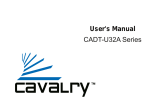
EN-CAHDD2BU3C-ZB
4
Open up the disk management utility of your specic OS. This will be the only control interface for your
EN-CAHDD2BU3C-ZB. For more info on the functions of your specic disk management utility, go to
http://www.cavalrystorage.com/manuals.aspx.
Wait for your drive(s) (which you should have just inserted) to appear in your disk management utility. If the drives
are blank, “unallocated” or have been formatted on a different operating system, they will need to be partitioned
and formatted before they can be used.
Windows users will need to check the “disk number” and see if a drive-letter has been assigned for their drive(s).
You can verify your drive by checking that the listed capacity for that disk # is close to that of the quoted drive size.
Mac users will need to check for their drive(s) in the left-hand column of Disk Utility. Cavalry drives will usually
be listed as a “DMI” drive of a size very close to the quoted capacity.
Example: A 1 TB size drive will appear as a 931.51 GB volume.
Once you have veried that your disks have the correct le-systems and have been assigned drive letters (Windows
only), you can proceed to Initializing and Formatting Your Disks, or proceed to the Disk Duplicator Installation
Guide below if you need to duplicate a disk with data on it.
A)
B)
C)
D)
E)
F)
Once you have veried the presence and health of both drives within your disk management utility, turn the dock
off and proceed to the next step.
Unplug the USB cable from the dock only. The duplication procedure will fail if the USB cable is not unplugged
rst!
Insert the source drive into slot # 1. This must be the drive containing the data you wish to copy.
Power the dock back on.
Insert a blank or “unallocated” disk of equal or greater size into slot #2. This will be the target disk which will
contain an exact duplicate of the data contained on the source disk. Warning: The target disk will automatically be
erased before it can copy the data from the source disk.
Press and hold the Duplicate button for three seconds. This will begin the disk duplication process.
Wait for the process to complete. With large volumes of data, it may take hours. During this time, the drive LEDs
on the front panel will blink continuously; indicating that the duplication process is under-way. Check on page 6 for
a detailed description of the LED codes.
Once both drive LEDs have settled to a continuous (non-blinking) solid green color, the duplication process will be
complete, and it will then be safe to use or remove the drives.
Now you can plug the USB cable back in. Check for both disks in your disk management utility. Windows users
may need to assign a new drive-letter in order to access the target disk within (My) Computer.
A)
B)
C)
D)
E)
F)
G)
H)
I)
2
STEP 2: Disk Duplicator Guide
2
CHAPTERINSTALLATION GUIDE
2
STEP 2: JBOD (Standard) Guide
JBOD means “Just a Bunch Of Disks”. It is the default setting of most external storage devices and allows you to
access each disk, in each bay, separately. New disks usually need to be formatted, partitioned or initialized. Older disks
with data already on them will usually appear -- ready to be used -- within (My) Computer. Although, occasionally an
older disk may need to have a new drive-letter assigned (Windows users), before they can be used. All of these
functions must be performed within your disk management utility.
Before you try to duplicate a drive, you rst need to check which drive has data on it, check the health of the source and
target drives, and make sure each drive is plugged into the correct drive-bay. Otherwise you may accidentally erase the
data drive! You can do all of these things using the JBOD guide above.











